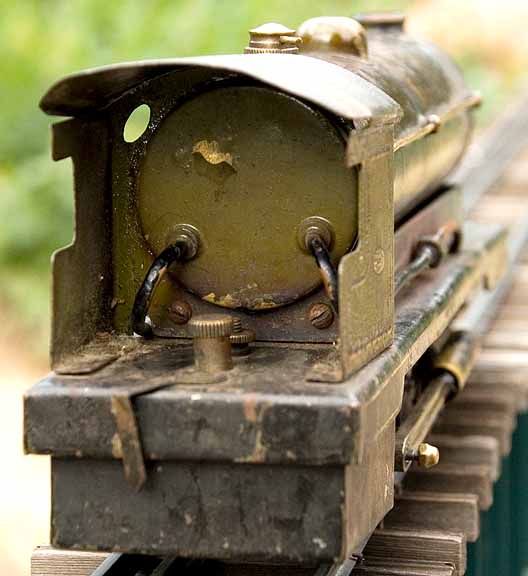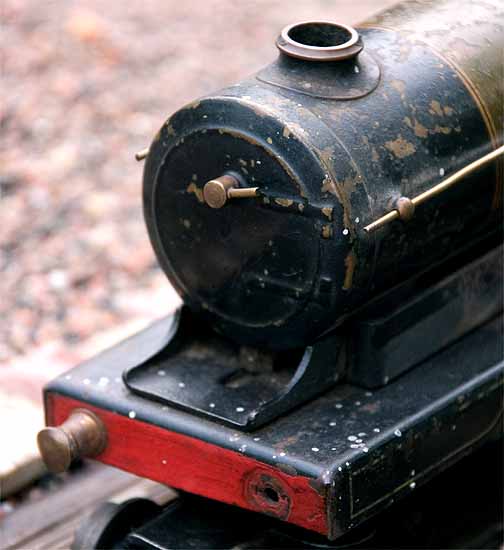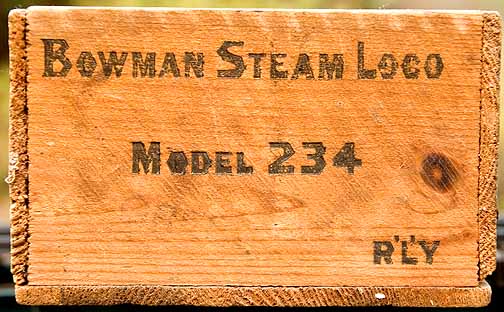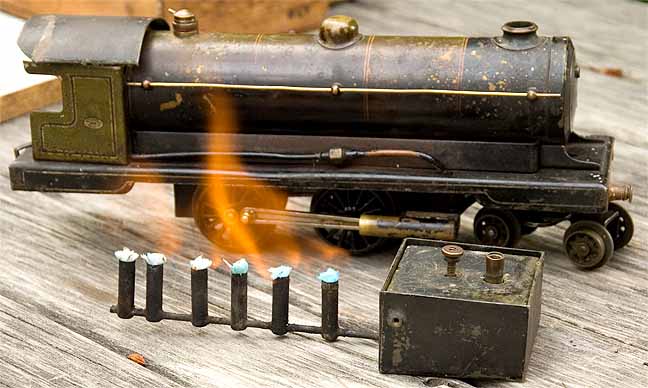
Back to Loco of the Month homepage
Back to Sidestreet Bannerworks
.
August 2007
Bowman 4-4-0
by Marc Horovitz

Bowman Models was the brainchild of Geoffrey Bowman Jenkins of Great Britain, who started the business in 1923 in association with another company called Hobbies. Hobbies had been long established, their forté being scrollsaws (fretsaws in Britain) and the myriad projects in wood associated with them. Bowman and Hobbies first effort together was making model boats, with Bowman Models making the steam engines and Hobbies supplying the wooden hulls. Jenkins then went on to develop a line of stationary steam engines and, finally, an 0-gauge railway system. In 1935, he severed his relationship with Hobbies and the Bowman line of engines ceased production. Hobbies needed someone to fill the gap, as steam models were still much in demand, and they found another Geoffrey, this one named Malins. But that's another story.
The object of this month's scrutiny is Bowman's #234, 4-4-0 "Express" engine, the star of the railway line. This engine is simple in the extreme, even more so than the Mamod engines that arrived half a century later. It has a pair of single-acting oscillating cylinders that drive the rear axle. The front axle is unpowered (sort of making it a 4-2-2-0, or something). The tender is entirely ornamental. There is a steam pipe leading from the boiler to each of the cylinders. Atop the boiler is a safety valve and at the front is an overflow plug. That's it. There's no throttle, reversing gear, or even lubricator. The engines were originally fitted with felt-like material on the piston rods, behind the brass pistons. These were to be soaked with oil and probably did a pretty good job of lubricating the cylinders, at least for a while. Unfortunately, on my example, these felts were long gone.
The locomotive is supplied with a capacious alcohol tank that feeds half a dozen wicks spaced out under the pot boiler. The top of the fuel tank is actually a small tray that houses a lead weight, no doubt intended to add a little traction and balance. There's a screw-on filler cap and a screw-type overflow plug on the side of the tank.
The engine is robustly made of heavy-gauge metal. Although it runs on gauge-0 track, it is closer to gauge 1 in size and proportion. Bowman also supplied lithographed-tin coaches to go with this engine. I have none of these, alas. The engines were offered in a variety of different liveries. Mine is the green LNER version. These engines were obviously made to last, and last they did. Bowman engines, despite being three-quarters of a century old, are one of the most commonly seen miniature steam locomotives on eBay.
As you can no doubt see from the picture, this month's example has been through the wars. There is a missing buffer and the boiler is blackened by many fires. Paint is chipped off the cylinders and elsewhere and the cab roof has a distinct crease in it. The engine just oozes character. But would it actually go?
The run
Since I hadn't run the engine before, I gave it a good lubing on the bench and put some compressed air to it. It ran strongly and without complaint, always a good sign. I removed the burner to check the state of the wicks and found most of them gone and the remainder in a sad way. I removed the remnants, replacing them with strands of ceramic fiber, guessing at the proper density.
Then I took the engine outside, filled the fuel tank, and gave the burner a test outside the engine. All wicks burned well, so I replaced the burner in the engine, filled the boiler until water came out the overflow port in the smokebox, and set it on the track. I relit the wicks and waited. The boiler is large and it took about 15 minutes to get any action on this cool evening. I had wondered what the brass rod protruding from the side of the safety valve was for. I'm guessing it is so you can easily tweak the valve to check the state of the boiler.
With the safety valve finally blowing off steadily, I gave the engine a push. There was little sign of life, even though steam seemed to be up. I let it cook a little longer and tried again. Nothing. This didn't make sense, given how well the engine ran on air. There were no obvious leaks, so the only thing I could think of was that the safety valve was releasing at a very low pressure.
I dropped the fire and, when cool, removed the safety. Ahah! The regulating nut on the valve had come loose to the point that there was little compression at all on the spring. I tightened it up, replaced it in the boiler, and relit the fire. Steam came up quickly since the water was still warm.
This time when I gave it a push, it definitely wanted to go and, in fact, did run a few yards before showing signs of fatigue. I helped it along, but to no avail. This time I figured that the wicks were packed too tightly, so decided to blow out the fire and remove a strand from each to see if that would perk things up.
Then a very strange thing happened. I gave the fire a puff to blow it out. Instead of going out, it expanded, sending flames up around the sides of the boiler. All I can think is that there must have been incomplete combustion before and a lot of alcohol vapor was escaping, unburned. When I blew on the fire, it flared up and ignited those vapors, which continued to burn.
In any event, that was all the engine needed. It was off, running strongly. Since there is no throttle, there are only two ways of controlling the speed on an engine like this. One is to hang a train onto the end of it, which I couldn't because the tender's coupler is gone, or to adjust the wicks (or cap them -- caps were originally supplied with the engine), which I couldn't because they were all lit at the moment.
I needn't have worried, though. Even the top speed wasn't too fast and I was easily able to keep up with it. The old war horse made several laps of the track in fine style. The engine's steam-roller wheels and my handlaid switches were not always in perfect agreement and sometimes the engine had to be offered a little physical encouragement to help it over the rough spots. The felt pads in the cylinders being gone, the lubrication wasn't all one might hope for, but the engine ran well despite it, putting on a fine performance in the cool evening air.

|
|
|
| Builder | Bowman Models |
| Date built | Circa 1930 |
| Gauge | 0 {32mm) |
| Scale | Nothing definite |
| Boiler | Pot |
| Fittings | Safety valve, overflow plug on smokebox |
| Fuel | Alcohol |
| Blow-off pressure | 15 psi |
| Cylinders | Two, single-acting oscillators |
| Reversing gear | None |
| Lubricator | None |
| Weight | 4 pounds, 2 ounces (loco and tender) |
| Dimensions | Length (loco and tender), 18-1/2"; width, 2-3/4"; height, 4-3/8" |










Back to Loco of the Month home page
Back to Sidestreet Bannerworks home page
This page and its contents
Copyright Sidestreet Bannerworks, 2007
.